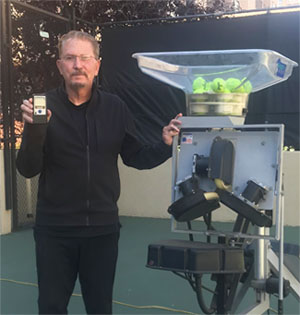Your Strokes:
Drew Forehand
John Yandell
I have worked with players at all levels, including many, many recreational players. But I always enjoy getting the chance to work with high level juniors and college players. (Click Here to read about my work with Ingrid Neel, then one of the top college players in the country.)
So I was excited when my old friend Barry Gilbert (yes brother of Brad) came to California to see his parents and brought his sons, Drew and Gavin, to my court to do high speed video analysis. Drew is 15 and going into high school and Gavin is 10.
Both are accomplished players, but we decided to look first at their forehands, then their serves. More on Gavin in a future article, but here I want to focus on Drew who made an amazing jump in a couple of hours and actually added 10mph to his forehand speed off the racket.
The Myth of the Tennis Tip
If you are familiar with most lessons they are a combination of verbal tips and ball feeding. “Good! Good! Better!" But is that “better" actually true? Sadly in the majority of the lessons I've observed over the years, the answer is usually no.
There are two reasons, verbal tips are imprecise, sometimes inaccurate, and don't affect how players actually learn. The second reason is that coaches have no actual data on what is happening. (Click Here to read my article on the Myth of the TennisTip.)
All the research shows that players learn visually and kinesthetically—by image and by feeling--not through words. Some players can translate verbal information in internal mental images and the corresponding feelings—most can't.
This why for over 25 years I have used video on court. Not only to show players where they are with a given stroke, but to use the video in side by side analysis with pro models.
We identify key positions in the strokes of elite players, then compare them to the student. We then help players create their own internal images and feelings, modeling the positions without the ball.
The Turn
For Drew on his forehand, the first key was to improve his turn. And the key to the turn for any player is the left arm stretch.
Drew's left arm was bent and never straightened out completely. Although his shoulders were turned, they were around 90 degrees or less to the net.
The pro models we used showed that all the top players achieve some version of the left arm stretch. The arm is roughly parallel to the baseline and perpendicular to the sideline.
This causes the shoulders to turn significantly further, something like 110 degrees or more to the net. Because of Drew's semi-western grip we used Novak as a model.
The other key position is the extension of the forward swing. This is the furthest point the hand and racket travel upward and outward toward the target, before moving backwards in the deceleration phase.
We could see on the video that Drew wasn't making this second key extension position either.
After looking at the side by side and working on the pro model positions without the ball, I had Drew close his eyes and move through the swing, imagining how it looked inside his mind's eye and how it felt in his body. Then we went back to hitting balls to see if Drew moved toward either position and how close he got.
Increments
Typically players move toward the model positions in increments, through a series of successive approximations over time. Which brings up another false assumption in traditional teaching—a verbal description of a change is enough to instantly solve a problem.

But what we saw with Drew and the imagery we created was a huge shift toward the left arm stretch and the corresponding additional shoulder turn. There was less shift toward the extension, but it was greater on some balls than others.
That didn't surprise me because as I said, these changes come in increments over time, but I was excited about the change on the turn and left arm stretch.
So that definitely looked like technical improvement. But how can you be sure that the changes are having a positive effect on the nature of the ball the player is producing?
With a pocket radar gun that measures before and after speed. But when doing this type of groundstroke speed comparison, it's important to have a precise, consistent ball feed.
That's why I use my trusty Sports Attack ball machine which delivers the ball with great accuracy and at the same speed on every ball. That is a prerequisite for valid speed measurements with the radar gun.
What Did the Gun Show?
When Drew started hitting forehands after the modeling work, the sound of the ball off his racket told me his velocity was significantly increased. But how much?
In the first series of speed measurements, the gun showed that his speed range was between 69mph and 79mph. Most were in the middle 70's and the average speed over about a dozen forehands was 75mph.
When we put the gun back on him after his improved turn, it showed that the sound of the ball off his racket wasn't some illusion. His speed range was between 78mph and 91mph.
Most of his forehands were in the mid 80s. The actual average was 85mph.
So in less than two hours Drew had effortlessly picked up 10mph—from an average of 75mph to 85mph. That was huge!
His extension position continued to vary but that is something he can work on after he fully consolidates the turn and the left arm stretch. Better extension might increase the speed even further and would definitely give him more control and consistency in creating and varying the amount of spin.
Barry brings his boys to California every summer, so I am hoping to see them next year and see how Drew has progressed!




